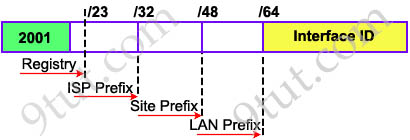IPv6 Questions 3
Note: If you are not sure about IPv6, please read our IPv6 tutorial.
Question 1
Explanation
A IPv6 Unique Local Address is an IPv6 address in the block FC00::/7, which means that IPv6 Unique Local addresses begin with 7 bits with exact binary pattern as 1111 110 -> Answer B is correct.
Note: IPv6 Unique Local Address is the approximate IPv6 counterpart of the IPv4 private address. It is not routable on the global Internet.
Question 2
Explanation
Neighbor Discovery Protocol is an umbrella that defines these mechanisms:
+ Subsitute of ARP – Since ARP has been removed in IPv6, IPv6 follows a newer way to find the link-layer addresses of nodes on the local link. This new mechanism uses a mix of ICMPv6 messages and multicast addresses
Reference: https://supportforums.cisco.com/document/77521/ipv6-neighbor-discovery-protocol-ndp
Question 3
Question 4
Explanation
Only three connection types are commonly known and used in Internet Protocol version four (IPv4) networks: unicast, multicast and broadcast. A fourth connection type, Anycast, was unknown until IPv6 made it a standard connection type. Anycast is not standardized in IPv4 but can be emulated. IPv4 Anycast addressing is a good solution to provide localization for services and servers in order to obtain robustness, redundancy and resiliency.
The basic idea of Anycast is very simple: multiple servers, which share the same IP address, host the same service. The routing infrastructure sends IP packets to the nearest server (according to the metric of the routing protocol used). The major benefits of employing Anycast in IPv4 are improved latency times, server load balancing, and improved security.
Reference: http://citeseerx.ist.psu.edu/viewdoc/download?doi=10.1.1.116.6367&rep=rep1&type=pdf
Question 6
Question 7
Explanation
Floating static routes are static routes that have an administrative distance greater than the administrative distance (AD) of another static route or dynamic routes. By default a static route has an AD of 1 then floating static route must have the AD greater than 1 -> Answer A is correct as it has the AD of 201.
Question 8
Explanation
Each ISP receives a /32 and provides a /48 for each site-> every ISP can provide 2(48-32) = 65,536 site addresses (note: each network organized by a single entity is often called a site).

Each site provides /64 for each LAN -> each site can provide 2(64-48) = 65,536 LAN addresses for use in their private networks.
So each LAN can provide 264 interface addresses for hosts.
-> Global routing information is identified within the first 64-bit prefix.
Now let’s see an example of IPv6 prefix: 2001:0A3C:5437:ABCD::/64:

In this example, the RIR has been assigned a 12-bit prefix. The ISP has been assigned a 32-bit prefix and the site is assigned a 48-bit site ID. The next 16-bit is the subnet field and it can allow 216, or 65536 subnets. This number is redundant for largest corporations on the world!
The 64-bit left (which is not shown the above example) is the Interface ID or host part and it is much more bigger: 64 bits or 264 hosts per subnet! For example, from the prefix 2001:0A3C:5437:ABCD::/64 an administrator can assign an IPv6 address 2001:0A3C:5437:ABCD:218:34EF:AD34:98D to a host.
Question 9
Explanation
Link-local addresses refer only to a particular physical link and are used for addressing on a single link for purposes such as automatic address configuration and neighbor discovery protocol. Link-local addresses can be used to reach the neighboring nodes attached to the same link. The nodes do not need a globally unique address to communicate. Routers will not forward datagram using link-local addresses. All IPv6 enabled interfaces have a link-local unicast address.
A link-local address is an IPv6 unicast address that can be automatically configured on any interface using the link-local prefix FE80::/10 (1111 1110 10) and the interface identifier in the modified EUI-64 format. Link-local addresses are not necessarily bound to the MAC address (configured in a EUI-64 format). Link-local addresses can also be manually configured in the FE80::/10 format using the “ipv6 address link-local” command.
Reference: http://www.cisco.com/c/en/us/support/docs/ip/ip-version-6-ipv6/113328-ipv6-lla.html
In summary, if you do not configure a link-local on an IPv6 enabled interface, it will automatically use the FE80::/10 and the interface identifier in the modified EUI-64 format to form a link-local address.
Question 10



Q10
Which tunneling mechanism embeds an IPv4 adrress within an Ipv6 address?
A. Teredo
B. 6to4
C. 4to6
D.GRE
E. ISATAP
La ser B.
Leer bien la pregunta, dice “embeds” y 6to4 embeds IPv4 address unto to IPv6